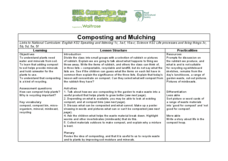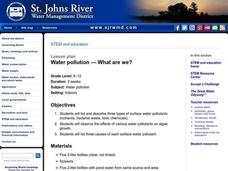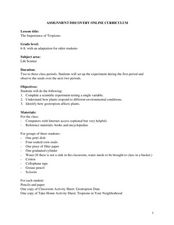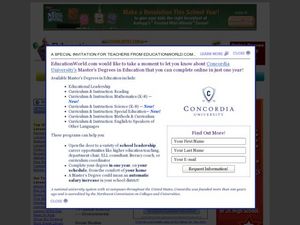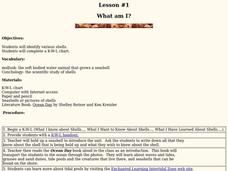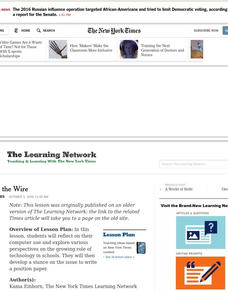Curated OER
Popcorn Geography
Students use kernels to create a "Top Corn-Producing States" map or graph. They read and round off numbers. Students identify on a U.S. outline map the location of corn-growing states. They create a visual (map or graph) illustration...
Curated OER
Weather and Seasons: Mt. Seymour Winter Fieldtrip
Students explore winter adaptations and glare. In this winter weather instructional activity, students discuss the season of winter and how animals and plants adapt to the changing weather. Students discuss the glare off snow and make...
Curated OER
Composting and Mulching
Second graders define composting and recognize what can be composted. In this composting and mulching lesson, 2nd graders classify objects or pictures as good or bad for composting. Students write a story about life in the compost heap.
Curated OER
What Are We?
Students list and describe three types of surface water pollutants. They observe the effects of various water pollutants on algae growth. Three causes of each surface water pollutant is listed.
Curated OER
Eating Plants
Learners identify parts of a plant. In this life science instructional activity, student groups locate the leaves and fruits on vegetables, then find the roots. Lesson includes extension activities and background teacher information.
Curated OER
The Importance of Tropisms
Students investigate plant tropisms using the scientific method. In this life science lesson, students learn about tropisms and test the response of corn seedlings to gravity. Response questions, extensions, and an adaptation for older...
Curated OER
Quality of Rice
Sixth graders research how farmers irrigate, harvest, and keep high standards of rice. In this farming instructional activity, 6th graders discover how rice, wheat and soy beans are farmed. Students make a chart showing the similiarities...
Curated OER
Troubled Times
Students address their questions, anxieties and other feelings about the changes in American society since the terrorist attacks on the United States on September 11, 2001 and the subsequent reactions around the world.
Curated OER
Let's Get Warm!
Learners investigate various methods that animals use to warm up in cold weather. They also explore the science principals involved. They then identify a human parallel, discuss what we can learn from nature, and create multimedia...
Curated OER
Exploring the Exponential Function
Learners collect and analyze data regarding exponential functions of the form y = abx. Students explore the affects of changing parameters on the graph of the function.
Curated OER
Beautiful Butterflies
Young scholars discover the changes a caterpillar goes through in order to become a butterfly. In this early childhood lesson plan, students identify the various parts of the anatomy of a caterpillar and butterfly, as well as the...
Curated OER
New Food Saves Lives, Could End Hunger
Students locate the country of Niger, then read a news article about a new type of food that is being used to fight childhood hunger in Africa. In this current events lesson, the teacher introduces the article with map and vocabulary...
Curated OER
What Am I?
Learners identify various shells. For this oceanography lesson, students create a KWL chart to activate background knowledge on shells. Learners read the book Ocean Day and learn about waves, tides, and the seashells that can be found on...
Curated OER
Gardening with Your Students
By growing a class or school garden you can teach students about the environment, the life cycle of a plant, and healthy eating.
Curated OER
Skeletal System (Continued)
Students examine human bones. For this skeletal system lesson, students review the functions and locations of bones in the human body. Students work in groups to complete an activity where they discover why bones are hollow and discuss...
Curated OER
Trees and Erosion
Students examine the connection between trees and erosion. In this erosion lesson students experiment with the effects of rain on a hillside. Students investigate the number of trees and the amount of erosion.
Curated OER
Busting Myths Using Science in the Classroom
Use the Mythbuster method and other exciting activities to jazz up your scientific method lessons!
Curated OER
Process of Mitosis
Learners discover through whole-class role play, the process of mitosis. They will all become a chromosome and demonstrate how they line up 23 to 23.
Curated OER
Extra, Extra Read All About It
Looking for an interactive roll playing instructional activity? Young actors practice reading and rereading decodable texts with expression. They interact with the play, "The Boy Who Wanted the Willies," by Aaron Shepherd within this...
Curated OER
Plant Needs
Students explore the needs of plants. In this plants biology lesson, students work in groups to perform an experiment with tomato plants. Each group records observations in a journal, takes pictures, and interprets the results of...
Curated OER
Food Labels
Students study Nutrition Facts labels. In this life science activity, students explore Nutrition Facts labels, then determine and analyze the nutrients found in a variety of foods. Additionally students construct bug boxes used to...
Curated OER
Too Much of a Sweet Thing
Students examine the growing prevalence of processed sugar in the American diet, first through a demonstration that makes graphically clear the amount of sugar an average boy and girl consumes on a daily basis.
Curated OER
Minerals of the Earth
Young scholars learn and practice identifying Earth's minerals and their properties. Working in small groups, they evaluate minerals. This is a well-described lesson, which students enjoy.
Curated OER
Down to the Wire
Students reflect on their computer use and explore various perspectives on the growing role of technology in schools. They develop a stance on the issue to write a position paper.




